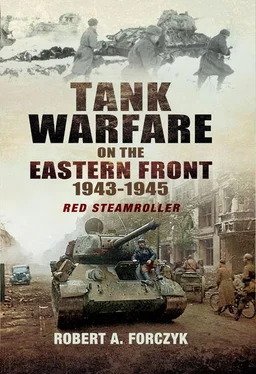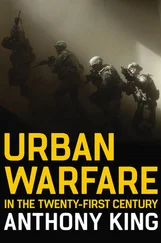Named after Count Pyotr A. Rumyantsev-Zadonaisky (1725–96), one of Catherine the Great’s generals. The Stavka named a number of large operations after heroes from Catherine’s wars and the later Napoleonic Wars, including Rumyantsev, Kutusov, Suvorov and Bagration. The Communist ability to use the names of formerly-reviled aristocrats to add lustre to military operations was amazing, akin to Orwell’s ‘double-think’.
General-major Boris S. Bakharov was relieved of command after Prokhorovka – one of the few heads to roll for that disaster. Thereafter, the 18 TC was commanded by his deputy for a time.
Panzer-Abteilung 51 had been sent to Bryansk to refit after Zitadelle and was in the process of receiving 96 factory-fresh Panthers. The battalion was attached to Großdeutschland.
Manganese and molybdenum were added to steel in armour plate on tanks to improve hardening. Without these ores, German armour plate was significantly more susceptible to armour-piercing ammunition. The two primary manganese ore mines were located at Marganets and Ordzhonikidze on the northern/western bank of the Dnepr.
Eberbach commanded three different Panzerkorps between 15 October and 15 November 1943. This was a ridiculous misuse of one of Germany’s best senior panzer leaders. Balck was also being bounced around between commands.
The Soviet cavalry corps of late 1943 was vastly different from the earlier Red Army cavalry formations. The 1 GCC included three tank regiments with an authorized strength of 90 T-34s and 21 T-70s, as well as an SAP with 20 SU-76 self-propelled guns. The corps had an authorized strength of 21,000 men, 19,000 horses and several hundred trucks.
This division was formed from the remnants of the 60.Infanterie-Division (mot.) destroyed at Stalingrad. When it arrived at Narva, it had no attached tanks.
Either von Manstein or Hube could have anticipated these supply problems and ensured that III Panzerkorps was provided with tracked RSO supply vehicles which could move through mud, or coordinate with the Luftwaffe to provide the panzer spearheads with air drops, but they only made minimal efforts to ensure Breith got fuel and ammunition to his forward units. German operational planning during Wanda was sub-par.
On 27 January 1944, Hitler ordered the Sd.Kfz.164 ‘Hornisse’ tank destroyer renamed as the ‘Nashorn’. This vehicle was similar to the Sd.Kfz.165 ‘Hummel’ self-propelled 15cm howitzer, since both were based on the Pz IV chassis.
Von Edelsheim commanded Panzergrenadier-Regiment 26 in the original 24.Panzer-Division at Stalingrad but was flown out of the pocket in November 1942.
Most of the tungsten core ammunition had been withdrawn from service after Kursk due to shortage of this vital metal, but Tiger units still received some APCR rounds.
Christopher W. Wilbeck, Sledgehammers: Strengths and Flaws of Tiger Tank Battalions in World War II (Bedford, PA: the Aberjona Press, 2004), pp. 18–23.
Thomas L. Jentz, Panzertruppen: The Complete Guide to the Creation & Combat Employment of Germany’s Tank Force, 1943–1945, Volume II (Atglen, PA: Schiffer Military History, 1996), pp. 43.
Manfred Kehrig, Stalingrad: Analyse und Dokumentation einer Schlacht (Stuttgart: Deutsche Verlag-Anstalt, 1974), pp. 670.
Jentz, pp. 49.
Heinz Guderian, Panzer Leader (New York: Ballantine Books, Inc., 1968), pp. 234.
Samuel W. Mitcham Jr., Hitler’s Legions: The German Army Order of Battle, World War II (New York: Stein & Day Publishers, 1985), pp. 387.
Guderian, pp. 237.
Guderian, pp. 239.
Meldung der Sonderkommission des OKH, 27 June 1941, NAM (National Archives Microfilm), series T-315, Roll 744, frame 729.
IIa, lib, Tatigkeitsbericht Verlustliste, Apr 1 – Oct 31, 1942, PzAOK 1, NAM (National archives Microfilm), series T-313, Roll 36.
Ernst Rebentisch, The Combat History of the 23rd Panzer Division in World War II (Mechanischsburg, PA: Stackpole Books, 2012), pp. 496–500.
Hans Schäufler, Knights Cross Panzers: The German 35th Panzer Regiment in WWII (Mechanichsburg, PA: Stackpole Books, 2010), pp. 203.
Armin Bottger, To the Gates of Hell: The Memoir of a Panzer Crewman (Barnsley, UK: Frontline Books, 2013).
Bottger.
Jentz, pp. 34.
Wolfgang Schneider, Panzer Tactics: German Small-Unit Armour Tactics in World War II (Mechanicsburg, PA: Stackpole Books, 2005), pp. 326.
Artem Drabkin and Oleg Sheremet, T-34 in Action (Barnsley, UK: Pen & Sword, 2006), pp. 128.
Otto Carius, Tigers in the Mud (Mechanicsburg, PA: Stackpole Books, 1992), pp. 3–20.
The United States Strategic Bombing Survey: The Effects of Strategic Bombing on the German War Economy (Washington, DC: U.S. Government Printing Office, 1945), Tables 14, 15.
Lukas Friedli, Repairing the Panzers: German Tank Maintenance in World War 2 , Volume 2 (Monroe, NY: Panzerwrecks, 2011), pp. 151.
Adam Tooze, The Wages of Destruction: The Making and Breaking of the Nazi Economy (New York: Penguin Books, 2006), pp. 552–589.
Tooze, pp. 569.
Walter J. Spielberger, Panzer IV and its Variants (Atglen, PA: Schiffer Military History, 1993), pp. 60.
Spielberger, pp. 80.
Tooze, pp. 152–154.
Steven J. Zaloga, Panther vs. Sherman: Battle of the Bulge 1944 (Oxford: Osprey Publishing, 2008), pp. 13.
Michael Winninger, OKH Toy Factory: The Nibelungenwerke, Tank Production in St. Valentin (Andelfingen, Switzerland: History Facts, 2013), pp. 184–205.
Roddy MacDougall and Darren Neely, Nürnberg’s Panzer Factory (Monroe, NY: Panzerwrecks, 2011), pp. 53.
Albert Speer, Inside the Third Reich (New York: Simon & Schuster, 1970), pp. 217.
Walter J. Spielberger, Panther and its Variants (Atglen, PA: Schiffer Military History, 1993), pp. 244.
Spielberger, Panther and its Variants pp. 244 and Thomas L. Jentz, Germany’s Panther Tank: The Quest for Combat Supremacy (Atglen, PA: Schiffer Military History, 1995), pp. 89.
Spielberger, Panther and its Variants pp. 106.
Tooze, pp. 602.
Tooze, pp. 598.
Читать дальше








![John Stieber - Against the Odds - Survival on the Russian Front 1944-1945 [2nd Edition]](/books/405234/john-stieber-against-the-odds-survival-on-the-russian-front-1944-1945-2nd-edition-thumb.webp)



